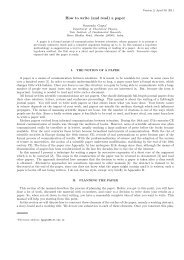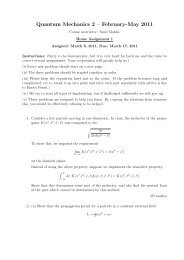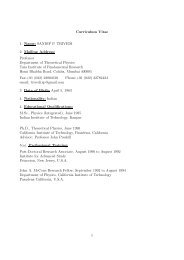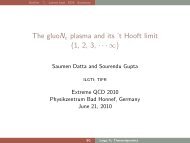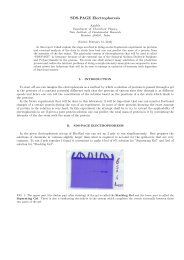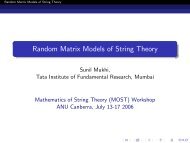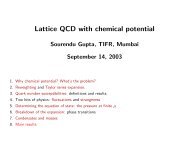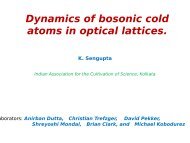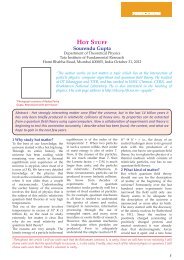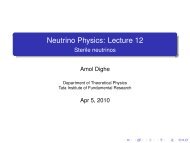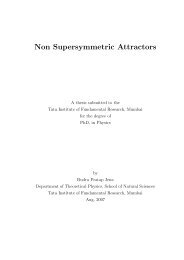A Hitchhikers Guide through the IceCube Detector - Department of ...
A Hitchhikers Guide through the IceCube Detector - Department of ...
A Hitchhikers Guide through the IceCube Detector - Department of ...
You also want an ePaper? Increase the reach of your titles
YUMPU automatically turns print PDFs into web optimized ePapers that Google loves.
„ A Hitchhiker`s guide to<br />
<strong>the</strong><br />
<strong>IceCube</strong> - <strong>Detector</strong> “<br />
JIGSAW10<br />
(Joint-Indo-German-Supernova<br />
Astroparticlephysics-Workshop)<br />
Timo Griesel<br />
02/25/2010 Mumbai, India
Outline<br />
Part I – <strong>IceCube</strong> & South Pole<br />
(Entertaining part)<br />
• A km³ <strong>Detector</strong> at <strong>the</strong> South Pole - <strong>IceCube</strong><br />
• DOMS and Deployment<br />
• Scientists at <strong>the</strong> South Pole<br />
Part II – Model Dependent SN Detection<br />
(Physics part)<br />
• Detecting <strong>the</strong> Deleptonizaton Peak with I³<br />
• QCD Phase Transition in I³<br />
• SN signatures for multiple hierarchies<br />
Timo Griesel JIGSAW Workshop – Mumbai, India 22-26/02/2010 page 1/26
<strong>IceCube</strong> Collaborators<br />
__________________________________________________<br />
USA (14) Europe (15)<br />
• IAS, Princeton, USA<br />
• University <strong>of</strong> Wisconsin-Madison, USA<br />
• University <strong>of</strong> Wisconsin-River Falls, USA<br />
• LBNL, Berkeley, USA<br />
• University <strong>of</strong> Kansas, USA<br />
• Sou<strong>the</strong>rn University and A&M College, Baton Rouge, USA<br />
• Alabama University, USA<br />
• Bartol Research Institute, Delaware, USA<br />
• Pennsylvania State University, USA<br />
• UC Berkeley, USA<br />
• UC Irvine, USA<br />
• Clark-Atlanta University, USA<br />
• University <strong>of</strong> Alaska, Anchorage, USA<br />
• Univ. <strong>of</strong> Maryland, USA<br />
• Universite Libre de Bruxelles, Belgium<br />
• Vrije Universiteit Brussel, Belgium<br />
• Université de Mons-Hainaut, Belgium<br />
• Universiteit Gent, Belgium<br />
• Humboldt Universität, Germany<br />
• Universität Mainz, Germany<br />
• DESY Zeu<strong>the</strong>n, Germany<br />
• Universität Dortmund, Germany<br />
• Universität Wuppertal, Germany<br />
• MPI Heidelberg, Germany<br />
• Uppsala University, Sweden<br />
• Stockholm University, Sweden<br />
• Imperial College, London, UK<br />
• Oxford University, UK<br />
• Utrecht University, Ne<strong>the</strong>rlands<br />
Japan (1)<br />
• Chiba University, Japan<br />
New Zealand (1)<br />
• University <strong>of</strong> Canterbury, Christchurch, NZ<br />
Timo Griesel JIGSAW Workshop – Mumbai, India 22-26/02/2010 page 2/26
The Location<br />
Amundsen-Scott Station<br />
<strong>IceCube</strong> !!!<br />
McMurdo Station (US)<br />
Timo Griesel JIGSAW Workshop – Mumbai, India 22-26/02/2010 page 3/26
The site<br />
Amundsen-Scott Station<br />
C130-Skyway<br />
AMANDA-Counting House<br />
South Pole<br />
EHWD - Camp<br />
I 3 -Counting House<br />
Timo Griesel JIGSAW Workshop – Mumbai, India 22-26/02/2010 page 4/26
Life at South Pole<br />
Timo Griesel JIGSAW Workshop – Mumbai, India 22-26/02/2010 page 5/26
<strong>IceCube</strong> <strong>Detector</strong><br />
Design Specifications<br />
• Fully digital detector concept.<br />
• Number <strong>of</strong> strings – 86<br />
• Number <strong>of</strong> surface tanks – 140<br />
• Number <strong>of</strong> DOMs – 5160<br />
• Instrumented volume – 1 km 3<br />
• Angular resolution <strong>of</strong> in-ice array < 1.0°<br />
Current Status<br />
• 79 strings, 138 surface stations<br />
• 4740 deployed DOMs,<br />
• Instrumented volume ~ 0.98 km 3<br />
• Work still in progress<br />
• Collecting physics data<br />
Timo Griesel JIGSAW Workshop – Mumbai, India 22-26/02/2010 page 6/26
South Pole Ice<br />
Absorption length [m]<br />
Eff. scattering length [m]<br />
Ice Properties<br />
• Clearest natural medium on earth<br />
• No Bioluminescence, no radioactivity<br />
• Scatter and Absorption length is<br />
influenced by:<br />
Dust layers<br />
Bubbles<br />
• Pole ice cap still growing<br />
• Upper glacier is moving with 10.2 m/a<br />
Ice Model Simulation<br />
• GEANT4 and Photonics simulation leads<br />
to a couple <strong>of</strong> slightly different Ice<br />
Models<br />
average photon absorption length:<br />
A 96m<br />
average track length:<br />
x( Ee ) (0.579<br />
0.017) cm<br />
Ee<br />
/ MeV<br />
Timo Griesel JIGSAW Workshop – Mumbai, India 22-26/02/2010 page 7/26
IC/DC – Deep Core<br />
Dust concentration<br />
Layout<br />
• 6 new strings<br />
• 60 high quantum efficiency PMTs<br />
each concentrated in <strong>the</strong> very clear<br />
ice below 2100 m<br />
• Seamlessly integrated with<br />
standard <strong>IceCube</strong> strings and<br />
modules<br />
Low energy threshold<br />
• Eth(n) < ~10 GeV due to ice clarity, high Q.E.<br />
PMTs (~18%→~25%) and closer spacing<br />
• Energy overlap at low end with SuperK; <strong>IceCube</strong><br />
at high end<br />
Very clear ice<br />
Information taken from D.Cowen Neutrino 2008 Poster<br />
Timo Griesel JIGSAW Workshop – Mumbai, India 22-26/02/2010 page 8/26
Digital Optic Module (DOM)<br />
Timo Griesel JIGSAW Workshop – Mumbai, India 22-26/02/2010 page 9/26
Effective Volume<br />
DOM acceptance :<br />
a(<br />
,<br />
)<br />
Effective Volume for Photons :<br />
<br />
N <br />
NPE<br />
( ,<br />
)<br />
No. <strong>of</strong> Photoelectrons<br />
No. <strong>of</strong> photons hitting <strong>the</strong> Module<br />
V<br />
<br />
eff<br />
<br />
eff A<br />
<br />
( a)<br />
p ( r,<br />
a)<br />
dV A 0.1811 0.0023m<br />
³<br />
No <strong>of</strong> Cherenkov Photons using Frank-Tamms Formula :<br />
N<br />
<br />
<br />
nm<br />
1<br />
600<br />
d<br />
2<br />
<br />
1<br />
<br />
<br />
<br />
x 325.4 x / cm 188.3<br />
5.5Ee<br />
/<br />
2<br />
²<br />
<br />
n<br />
<br />
300nm<br />
<br />
Ice <br />
MeV<br />
Effective Volume for e :<br />
e<br />
<br />
V ( Ee)<br />
N V (34.1 2.0) m³<br />
E<br />
eff<br />
<br />
<br />
eff<br />
e<br />
/<br />
MeV<br />
Effective Volume is not overlapping – no track information<br />
Timo Griesel JIGSAW Workshop – Mumbai, India 22-26/02/2010 page 10/26
DOM noise rate<br />
Average raw Rate <strong>of</strong> a single DOM:<br />
R DOM<br />
540 106<br />
raw<br />
Hz<br />
Applying an artificial Deadtime to <strong>the</strong> Rate<br />
leads to a poissonian noise Rate <strong>of</strong>:<br />
R DOM 281 21Hz<br />
<strong>IceCube</strong> (IC80) <strong>Detector</strong> noise rate:<br />
80<br />
R IC 1340000<br />
1800Hz<br />
Timo Griesel JIGSAW Workshop – Mumbai, India 22-26/02/2010 page 11/21
Deployment EHWD <strong>of</strong> <strong>IceCube</strong> DOMs - EHWD<br />
EHWD (Enhanced Hot Water Drill) designed to drill a 2450 m × 60 cm hole in ~30 hr.<br />
Thermal Power: 4.5 Megawatt<br />
Timo Griesel JIGSAW Workshop – Mumbai, India 22-26/02/2010 page 12/26
Drilling<br />
Timo Griesel JIGSAW Workshop – Mumbai, India 22-26/02/2010 page 13/26
Deployment Drilling <strong>of</strong> <strong>IceCube</strong> DOMs - Drilling<br />
__________________________________________________<br />
Top layer <strong>of</strong> packed snow is called firn.<br />
Hot water drill designed for ice drilling – it gets<br />
starter hole from firn drill (lower left).<br />
EHWD drill head entering hole (Top left and top<br />
right) .<br />
Timo Griesel JIGSAW Workshop – Mumbai, India 22-26/02/2010 page 14/26
Drilling<br />
Upper right: AMANDA OM in -840m<br />
Lower right: DOM low down in <strong>the</strong> hole<br />
Upper left: DOM hook up right before <strong>the</strong> low down<br />
Middle: Hooked up DOM<br />
Timo Griesel JIGSAW Workshop – Mumbai, India 22-26/02/2010 page 15/26
IceTop<br />
IceTop –<br />
Airshower detector<br />
Timo Griesel JIGSAW Workshop – Mumbai, India 22-26/02/2010 page 17/26
Data Acquisission<br />
Simplified scheme <strong>of</strong> <strong>the</strong> <strong>IceCube</strong> data acquission<br />
Programms and initialize <strong>the</strong> DOM.<br />
Responsible for time synchronisation<br />
Rebins data and<br />
performs online<br />
analysis<br />
DOM<br />
DOR Card String Hub pDaq SNDaq<br />
Generates digital<br />
signal<br />
Collects all data from <strong>the</strong><br />
string and corresponding<br />
IceTop station<br />
Sorts and separates<br />
Monitoring, Time, Event and<br />
SNData<br />
Controlls and Collects<br />
data flows<br />
from <strong>the</strong> complete<br />
detector<br />
Assigning tasks to<br />
subcomponents<br />
Timo Griesel JIGSAW Workshop – Mumbai, India 22-26/02/2010 page 17/26
SN Detection-Algorithm<br />
• pDAQ delivers raw rates (DOM-wise, 1.6384ms binning) SNDaq synchronizes and rebins data<br />
to 2ms binning >> fine for resolving most interesting structures in -signal<br />
• Analytic calculation <strong>of</strong> <strong>the</strong> kollektive rate deviation using Maximum-Likelihood<br />
Method (² -Minimization) in real time.<br />
2<br />
<br />
<br />
. <br />
<br />
2ln<br />
const<br />
L L<br />
<br />
<br />
<br />
<br />
<br />
Timo Griesel JIGSAW Workshop – Mumbai, India 22-26/02/2010 page 18/26<br />
DOM<br />
<br />
N DOM<br />
1<br />
2<br />
NDOM 2 N<br />
<br />
DOM<br />
i<br />
<br />
<br />
i<br />
ri<br />
i<br />
i<br />
<br />
<br />
<br />
2<br />
2<br />
2<br />
<br />
i0<br />
<br />
i <br />
i0<br />
<br />
i<br />
i0<br />
<br />
i<br />
• Estimate homogeneity <strong>of</strong> illumination over whole detector<br />
2<br />
N DOM<br />
r i<br />
<br />
i<br />
<br />
i<br />
<br />
N<br />
i0<br />
1<br />
2<br />
• Estimate significance <strong>of</strong> collective rate deviation on top <strong>of</strong> noise<br />
²(<br />
)<br />
<br />
<br />
<br />
i<br />
<br />
<br />
<br />
<br />
i<br />
<br />
<br />
i<br />
e<br />
<br />
<br />
<br />
<br />
<br />
<br />
<br />
2<br />
ri<br />
i<br />
i<br />
2<br />
2<br />
i<br />
/ <br />
• Calculate and per DOM from 10‘ data (excluding current position) in multiple binning<br />
i<br />
i<br />
/ 6.5 p( ²)<br />
99.9%<br />
• Trigger Conditions. Significance<br />
<br />
and (for any binning)<br />
• DOM Disqualification (Per Bin) on mean value, broadening and skewness <strong>of</strong> rate distribution
SNEWS<br />
SNEWS – SuperNova Early Warning System<br />
What happens when <strong>IceCube</strong> triggers a Supernova event ?<br />
Take data !<br />
Send SNEWS alert<br />
http://snews.bnl.gov/<br />
Members: Super-K, LVD,<br />
SNO, <strong>IceCube</strong>…<br />
SNEWS is <strong>the</strong> central drop-in center for Supernovae<br />
Explosion detections<br />
A single computer at LBNL collects alarm messages<br />
In case <strong>of</strong> a coincidend alam astronomer get informed<br />
Requirement for <strong>the</strong> minimization statistcal errors<br />
Coincidence <strong>of</strong> two experiments need to be within 10s<br />
False alarm rate
Signal hits [0.002s^-1]<br />
Signal hits [0.002s^-1]<br />
Deleptonization Peak<br />
Livermore @ 10kpc<br />
• Generate <strong>IceCube</strong> detector response for<br />
given signal using USSR<br />
(see talk Thomas Kowarik)<br />
• switch oscillations on<br />
Deleptonization peak can not be detected for SN at<br />
distances >2kpc<br />
time [s]<br />
Garching @ 10kpc<br />
Can we learn something about <strong>the</strong> hierarchy ?<br />
• Applying linar fits to different scenario signals<br />
• Histogram slopes <strong>of</strong> fits<br />
• Iterate and change SN distance<br />
Information from Thesis A.Piegsa 2009<br />
time [s]<br />
Timo Griesel JIGSAW Workshop – Mumbai, India 22-26/02/2010 page 20/26
Deleptonization Peak<br />
Probability<br />
Rate change @ 10kpc<br />
Calculating <strong>the</strong> 90% quantile and <strong>the</strong> fraction<br />
which leaks into <strong>the</strong> false scenario leads to <strong>the</strong><br />
conclusion that hierarchies are capable <strong>of</strong> being<br />
differentiated till:<br />
< 6 kpc (90% C.L.)<br />
Slope <strong>of</strong> <strong>the</strong> detector rate [hits/ms]<br />
Probability <strong>of</strong> false classification<br />
Note: This is only within <strong>the</strong> erros <strong>of</strong> <strong>the</strong><br />
underlying SN Model valid.<br />
Distance [kpc]<br />
Timo Griesel JIGSAW Workshop – Mumbai, India 22-26/02/2010 page 21/26
QCD Phase signal<br />
<strong>IceCube</strong> QCD phase transition signal @ 10kpc<br />
Initial signal based on Sagert et al. PRL 102, 081101 (2009)<br />
Timo Griesel JIGSAW Workshop – Mumbai, India 22-26/02/2010 page 22/26
Likelihood Ratio<br />
Using a likelihood Ratio Method as Separator<br />
Hypo<strong>the</strong>sis A<br />
Signal Hypo<strong>the</strong>sis A<br />
• Theoretical Hypo<strong>the</strong>sis A,B (e.g. SN Models)<br />
• Generate signals based on Hypo<strong>the</strong>sis A,B<br />
Hypo<strong>the</strong>sis B<br />
Signal Hypo<strong>the</strong>sis B<br />
• Calculate <strong>the</strong> Likelihood ratios<br />
(only use shape <strong>of</strong> <strong>the</strong> signal, no distance<br />
information)<br />
• Do this 10000 times<br />
<br />
<br />
A<br />
B<br />
<br />
<br />
L<br />
L<br />
L<br />
L<br />
A<br />
B<br />
B<br />
A<br />
<br />
<br />
1<br />
<br />
A 2 A 2<br />
(2ni<br />
Ai<br />
Ai<br />
) (2ni<br />
Bi<br />
Bi<br />
2<br />
²<br />
1<br />
<br />
B 2 B 2<br />
(2ni<br />
Ai<br />
Ai<br />
) (2ni<br />
Bi<br />
Bi<br />
2<br />
²<br />
) <br />
)<br />
<br />
Timo Griesel JIGSAW Workshop – Mumbai, India 22-26/02/2010 page 23/26
Likelihood Ratio QCD<br />
A<br />
10kpc<br />
B<br />
•Calculate histograms for several<br />
distances<br />
A<br />
30kpc<br />
B<br />
• Calculate <strong>the</strong> selectivity in units <strong>of</strong><br />
sigma („gap“) for each distance<br />
Timo Griesel JIGSAW Workshop – Mumbai, India 22-26/02/2010 page 24/26
Model Selectivity<br />
Work in progress<br />
QCD: PRL 102, 081101 (2009)<br />
Hadronic: PRL 102, 081101 (2009)<br />
Black Hole: ApJ 667 382-394 (2007)<br />
Livermore: Astrophys. J. 496 (1998) 216-225<br />
ONeMg: arXiv:9012.0260<br />
• Absolute Model shape dependent<br />
Timo Griesel JIGSAW Workshop – Mumbai, India 22-26/02/2010 page 25/26
Thank you !!!!!!<br />
Timo Griesel JIGSAW Workshop – Mumbai, India 22-26/02/2010 page 26/26






